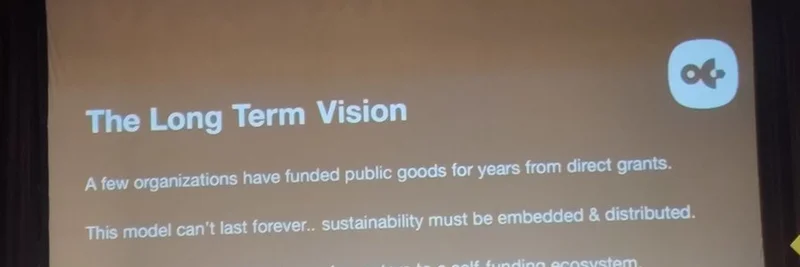In the fast-evolving world of blockchain, funding public goods—those essential projects that benefit everyone, like open-source tools and infrastructure—has often relied on grants from a handful of big players. But as a recent tweet from @alex__eth highlights, things are shifting toward more sustainable models, thanks to innovations like Octant App.
The tweet, posted by Alex, DAO Lead at Kleros, expresses excitement about a presentation by @vpabundance, Head of Impact at Octant. It showcases how Octant is leveraging DeFi (Decentralized Finance) to create self-sustaining funding for public goods. Notably, @ShutterNetwork and @nounsdao are set to be early adopters, signaling a broader trend in the crypto space.
Breaking Down the Vision
The captured slide from the presentation spells it out clearly: "The Long Term Vision." It points out that while a few organizations have funded public goods via direct grants for years, this approach isn't built to last forever. Instead, sustainability needs to be baked in and distributed across the ecosystem. The goal? Transition from relying on a small group of funders to a self-funding setup.
Examples on the slide include established projects like Yearn Finance, the Ethereum Foundation, Shutter, DRIPS, and Superfluid. These represent successful models where DeFi mechanisms generate ongoing yields to support ongoing development without constant grant-hunting.
For those new to the term, public goods in crypto are things like protocols, research, or tools that anyone can use freely, but they're often underfunded because there's no direct profit motive. Octant aims to fix that by allowing users to lock up tokens (like GLM from Golem), earn ETH rewards through DeFi strategies, and direct those earnings toward projects they care about.
How Octant Works in Practice
Octant, launched by the Golem Foundation in 2023, is designed as a modular platform for funding and allocating resources to public goods. Users participate in "epochs"—time-bound funding rounds—where they can propose projects, vote, and allocate funds. It's integrated with quadratic funding mechanisms, often in partnership with Gitcoin, which amplifies small donations for greater impact.
A key feature is turning idle treasury assets into productive yields. For instance, in a recent pilot with Shutter Network, Octant helped activate treasury capital to generate around $85,500 in annualized yield, as detailed in their community forum post. This not only funds public goods but also empowers communities to make decisions democratically.
Early Adopters: Shutter Network and Nouns DAO
Shutter Network, a project focused on encrypted transactions to prevent front-running on Ethereum, is diving in with Octant v2. Their integration aims to optimize treasury management and boost ecosystem strength through sustainable yields.
Similarly, Nouns DAO—a unique experiment in on-chain governance where daily NFT auctions fund community proposals—is collaborating closely. They've hosted joint events like the Ethereum App Town Hall with Octant, as seen in recent announcements. This partnership could mean Nouns using Octant's tools to make their funding more resilient and distributed.
Even the reply to Alex's tweet from @0xCrystar echoes the buzz: "bullish on nouns integration." It's clear the community sees potential here for long-term stability.
Why This Matters for Meme Tokens and Beyond
At Meme Insider, we usually dive deep into meme tokens, but this ties in perfectly. Many meme projects start as fun experiments but struggle with sustainability. Imagine meme DAOs using DeFi yields to fund ongoing marketing, development, or even charitable causes—turning hype into lasting impact. Octant's model could inspire meme communities to build self-funding mechanisms, reducing reliance on volatile token sales.
As crypto matures, shifts like this from grant dependency to DeFi-driven sustainability could redefine how we support innovation. If you're building in blockchain, check out Octant's docs to see how you can get involved in proposing or funding projects.
What do you think—could this be the future of public goods in crypto? Drop your thoughts in the comments or hit up the original tweet for more discussion.



